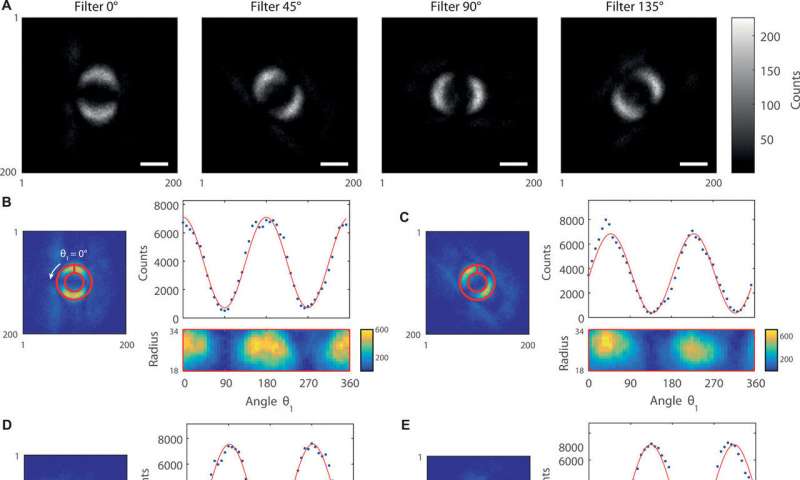A research team from the University of Glasgow has taken the first ever images of a phenomenon known as quantum entanglement. This phenomenon has been studied extensively by physicists since it was first described by Albert Einstein in 1935. When a pair of particles are entangled, their fundamental properties are linked. There is always a correlation between the same property of each particle.
A good way of thinking about this is by imagining a pair of gloves. If you hand someone a right-handed glove, then that person knows the other glove in the pair must be left-handed. When Einstein talked about this phenomenon in the EPR paper (named after its authors Einstein, Podolsky and Rosen), another physicist named Erwin Schrӧdinger was intrigued. Schrӧdinger tried to explain this idea of entanglement and quantum superposition through his famous thought experiment commonly known as Schrӧdinger’s Cat. The idea proposes a cat in a box with a barrel of gunpowder. There is a 50% chance that the barrel explodes and a 50% chance it doesn’t. Before opening the box, the gunpowder is in a superposition of exploded and unexploded. It’s said to be in both states at once. It’s only when you open the box that the barrel “collapses” to one of the two states. However, if you were to look at only the barrel, you could tell if the cat is alive or dead. If the gunpowder has not exploded, then the cat must be alive. If it has exploded, then the cat is (unfortunately) very much dead. Similarly, if you observe the cat and see that it’s alive, then the barrel will be in an unexploded state. So the states of the barrel and the cat are entangled. When you observe the state of one of them, you immediately know the state of the other.
“Einstein famously called this “spooky action at a distance”.”
This works in real life on a quantum level. If you take a pair of entangled particles and place them on opposite sides of a galaxy and then measure the spin of one of them, the other particle will instantaneously show the correlating spin. Einstein famously called this “spooky action at a distance”. That’s because this idea appeared to contradict his theory of relativity. It appears as though the particle measured initially is sending information to the other particle at a speed faster than the speed of light. It somehow lets the other particle know immediately that it has been measured and collapsed to one state. So what is actually going on?
Einstein favoured the theory that there were “hidden variables” at play. This theory assumes that there are some hidden variables held within the particles that we cannot measure and which give a type of instruction manual to each particle on how to act when measured. This theory was eventually proven wrong by Northern Irish physicist John Bell who showed through experimentation that there are no hidden variables which affect the states of entangled particles.
Quantum entanglement has been a subject of debate in physics for a long time now, but thanks to the team at Glasgow University we can now look this “spooky action” directly in the face. The images taken show two entangled photons (light particles) interacting and sharing their physical states. The team fired beams of entangled photons and captured them on camera as they went through four different phase transitions. The final images are a composition of the four phases.
“It’s an exciting result which could be used to advance the emerging field of quantum computing and lead to new types of imaging.”
In the paper published in the journal Science Advances, they state: “We hope that the present work will inspire and generate a new class of quantum imaging demonstrations and techniques relying on Bell-type entanglement… .” Paul-Antoine Moreau, lead author of the paper, told the BBC: “It’s an exciting result which could be used to advance the emerging field of quantum computing and lead to new types of imaging.”
“Quantum teleportation was thought to be a possibility using quantum entanglement for a long time.”
The implications of quantum entanglement are massive. Not only does it give a helping hand to the idea of quantum computing, but it is also turning science fiction into a reality. Quantum teleportation was thought to be a possibility using quantum entanglement for a long time. In 1997, a paper was published by a team from the University of Innsbruck in Austria explaining the possibility of teleportation using entanglement. The idea is to have three particles, two of which are entangled. Two particles are in one location, with one of them being entangled with the third particle in a different location. “The essential point is to perform a specific measurement on particles one and two which projects them onto the entangled state.”
In 1997 this was merely an idea, but in 2017 a team of researchers in China managed to actually teleport a photon from Earth up to an orbiting satellite 500 km away. If you imagine the entangled photons as the same particle, then teleportation is achieved by the transporting of information from one to the other, allowing for the second photon to adopt the identity of the first. “This work establishes the first ground-to-satellite up-link for faithful and ultra long distance quantum teleportation, an essential step toward global scale quantum internet,” said the team in 2017.
Quantum entanglement is a dream and a curse for physicists in the field today. It poses opportunities as well as problems. It’s not fully understood by any means but so far it has allowed us to do the impossible. Einstein knew that there was something strange and “spooky” about entanglement, and today we are lucky enough to start experiencing this oddity in more detail than ever before.






